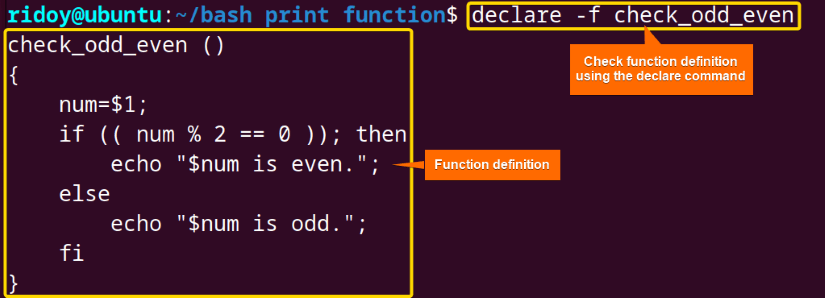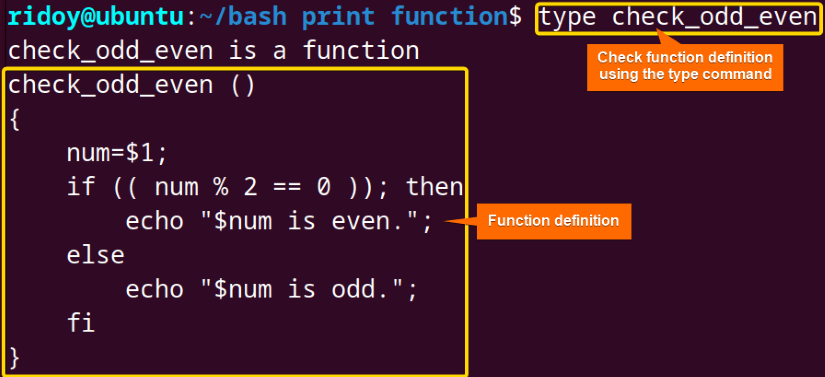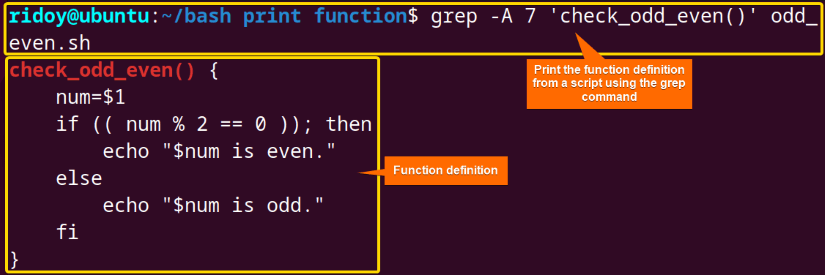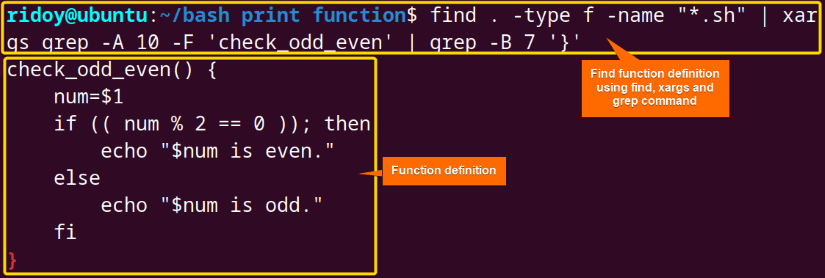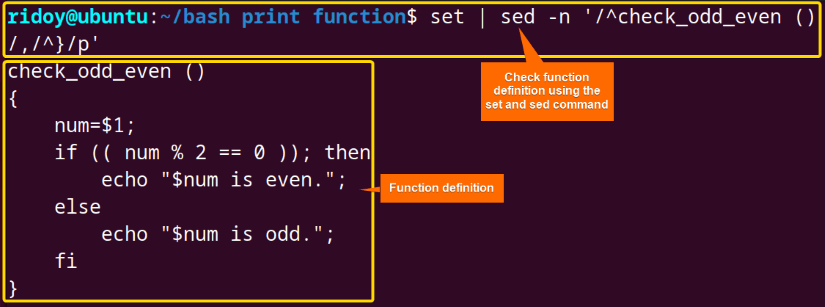Bash scripting involves writing sequences of commands in the Bash language to automate tasks, manage systems, and manipulate files and directories. Functions in Bash scripting are essential tools for organizing code and making scripts more modular and reusable. This guide will go through 8 different methods that you can use in bash scripting to print a function’s definition.
8 Methods to Print Function Definition in Bash
A Bash function is a set of shell commands grouped together to perform a specific task. It encapsulates a sequence of commands within a single unit, allowing for modular and reusable code in shell scripts. Whether it is a shell function or a bash script function you can always use commands like declare, type, typeset, or text-processing tools like grep, sed, or awk to print out the definition of that function. This article will showcase 8 different methods of printing function’s definition.
The content of the odd_even.sh bash script that is used to find function definition:
#!/bin/bash
# Function to check if the number is odd or even
check_odd_even() {
num=$1
if (( num % 2 == 0 )); then
echo "$num is even."
else
echo "$num is odd."
fi
}
# Take user input for the number
read -p "Enter a number: " number
# Call the function to check if the number is odd or even
check_odd_even $number
The shell function that is used to find function definition:
check_odd_even() {
num=$1
if (( num % 2 == 0 )); then
echo "$num is even."
else
echo "$num is odd."
fi
}
1. Using the “declare” Command
The declare command in Bash is used to declare variables and set their attributes. It provides a way to explicitly state the properties of variables, such as their type, scope, and read-only status. When used with the -f option, declare displays the definitions of shell functions. To find a function definition using the declare command, execute the following command:
declare -f check_odd_evendeclare -f check_odd_even displays the definition of the check_odd_even function. This command provides detailed information about the function, including its name and code implementation.
Here the shell function’s definition was printed using the declare command.
2. Using the “type” Command
The type command in Bash is used to determine how a name would be interpreted if it were used as a command. It provides information about whether the name refers to a shell built-in, a function, an alias, or an external executable file.
To find a function definition using the type command, simply provide the function’s name as an argument. If the function is defined within the current shell session or sourced from a script, the type command will display the function definition along with its name. Run the following command to do so:
type check_odd_eventype check_odd_even reveals how the shell interprets the check_odd_even command. It confirms whether check_odd_even is a function, an alias, or a shell built-in command.
Here the type command prints the check_odd_even shell function’s definition.
3. Using the “typeset” Command
The typeset command in Bash is used to set or display the attributes and values of shell variables. It is similar to the declare command and is often used interchangeably. typeset allows you to define variables and specify their properties, such as read-only, integer, or array.
To find a function definition using the typeset command, use the -f option followed by the function’s name. This command will display the definition of the function if it’s defined within the current shell session or sourced from a script. Run the following command to do so:
typeset -f check_odd_eventypeset -f check_odd_even command displays the definition of the check_odd_even function. It provides insights into the function’s attributes and scope within the shell session.
Here the typeset command with the -f option prints the check_odd_even shell function’s definition.
4. Using the “awk” Command
The awk command is a powerful text-processing utility in Unix and Linux environments. It is used for pattern scanning and processing of text files, enabling users to manipulate data based on specific patterns or conditions. In the following command, the awk command is used to find the function definition from a shell script:
awk '/^check_odd_even\(\)/,/^}$/' odd_even.shUsing awk '/^check_odd_even\(\)/,/^}$/}' odd_even.sh, the awk utility command processes the “odd_even.sh” file. It scans for lines between check_odd_even() and } in the file which indicates the function definition. Then it prints that into the command line.
Here the awk command prints the check_odd_even function’s definition from the odd_even.sh bash script.
5. Using the “sed” Command
The sed command, short for “stream editor“, is a powerful utility for processing and transforming text streams in Unix and Linux environments. It operates by reading input line by line, applying specified operations or commands, and then outputting the result. Here the sed command is used to find the function definition from a specific bash script:
sed -n '/^check_odd_even() {/,/^}/p' odd_even.shThe sed command with -n option suppresses automatic printing of pattern space, allowing selective printing. The pattern /^check_odd_even() {/,/^}/p specifies to print lines between the starting line containing check_odd_even() { and the ending line containing } in the file odd_even.sh. This command effectively extracts the definition of the check_odd_even function from the odd_even.sh script.
Here the sed command prints the check_odd_even function’s definition from the odd_even.sh bash script.
6. Using the “grep” Command
The grep command in Linux is a command line utility used for searching text patterns within files or standard input streams. It allows users to search for specific patterns or regular expressions in text files and display lines that match the specified criteria.
It can be used to find function definitions by searching for specific patterns such as the function’s name or curly braces that denote a function’s beginning and the end. Run the below command to find the check_odd_even() function’s definition from the odd_even.sh bash script:
grep -A 7 'check_odd_even()' odd_even.shThe grep -A 7 'check_odd_even()' odd_even.sh command searches the “odd_even.sh” file for the function “check_odd_even()”. It prints the function definition along with 7 lines following each occurrence.
Here the grep command finds and prints the check_odd_even function’s definition from the odd_even.sh bash script.
7. Using the “find” and the “xargs” Command
The find command in Linux locates files and directories based on specified criteria like name and size. It starts the search from a designated directory and applies filters such as name patterns and permissions. Meanwhile, the xargs command processes input items from standard input or another command, executing a command for each item, and enabling efficient handling of multiple items.
The find and the xargs commands can be utilized in conjunction to print a function’s definition from the bash file. Run the following command to find the check_odd_even function’s definition from all the shell script files of the current directory and its subdirectories:
find . -type f -name "*.sh" | xargs grep -A 10 -F 'check_odd_even' | grep -B 7 '}'The find . -type f -name "*.sh" | xargs grep -A 10 -F 'check_odd_even' | grep -B 7 '}' command searches for all the “.sh” files in the current directory and its subdirectories. It exacts a line containing check_odd_even() along with 10 lines after each occurrence. Then it prints 7 lines before each match of } from the already filtered strings.
Here the combination of the find, xrags, and grep command is used to find and print the check_odd_even function’s definition from all bash scripts of the current directory and its subdirectory.
8. Using the “set” Command With the “sed” Command
The set command in Linux is a built-in shell command used to set or unset shell options and positional parameters. When used without any arguments, it displays a list of all shell variables and functions, along with their values.
To find a function definition using the set command, redirect (pipe) its output to text-processing tools like grep, sed, or awk and filter the output based on the function name. Execute the following command to do so:
set | sed -n '/^check_odd_even ()/,/^}/p'When the set command is combined with sed, it allows for selective printing of text. In this command, sed -n suppresses the automatic printing of pattern space, allowing for controlled output. The pattern /^check_odd_even ()/,/^}/p instructs sed to print lines between the function definition of check_odd_even() and the closing brace }.
Here the set command with the sed command prints the check_odd_even shell function’s definition.
Conclusion
To sum it up there are many ways to print out the definition of a function whether it is a shell function or a bash script function. This article summarizes all those ways. I hope this article will make a positive impact on your shell scripting journey.
People Also Ask
What is the print function in bash?
The Bash shell doesn’t have a specific “print” function like other languages. Instead, you use the echo command to print text or variable values to the console. The echo command takes arguments, which are the items to be displayed, and prints them to the standard output. It is a fundamental command for displaying information in Bash scripts, and it is often used to provide feedback, output results, or simply show messages to users. The basic syntax is straightforward: echo [arguments]. Additionally, the printf command is another option for formatted printing in Bash, offering more control over the output’s structure and appearance.
How do you find the definition of a function in bash?
To find the definition of a function in Bash, the declare command with the -f option can be used. This command specifically displays the definition of shell functions. For example, executing declare -f <function_name> prints the definition of the specified function. It provides detailed information about the function, including its name and code implementation.
How to define a function in the bash shell?
To define a function in the bash shell, use the following syntax: function_name() { commands }. Replace function_name with the desired name of your function and commands with the set of instructions or actions the function should perform. For example, to create a function named my_function that echoes “Hello, World!”, you would write: my_function() { echo "Hello, World!"; }.
How to delete a Bash function?
To delete a Bash function, use the unset command followed by the function name. For example, to delete a function named my_function, you would use the command unset -f my_function. This command removes the definition of the specified function from the current shell session, making it unavailable for further use. Deleting a function can be useful for cleaning up your environment or removing unnecessary functions from memory.
How to define a Bash function that can be used in any script?
To define a Bash function that can be used in any script, you can add the function definition to your shell’s configuration file, such as .bashrc or .bash_profile. Open the file in a text editor and add your function definition at the end of the file. Ensure that the function definition is correctly formatted with the function keyword followed by the function name and its implementation. Save the file after adding the function. Once saved, the function will be available for use in any Bash script or interactive shell session.
What are the rules for function names in Bash?
In Bash, function names follow the same rules as variable names. They must start with a letter or an underscore and can contain letters, numbers, or underscores. However, they cannot start with a number. Function names are case-sensitive. Function names cannot contain special characters like spaces or punctuation marks, and they cannot be Bash keywords or reserved words. It is recommended to use descriptive names that reflect the purpose of the function for clarity and readability in your scripts.
How do I run a Bash function?
In Bash, there’s no special command to run a function. Simply call its name like you would any other command in your terminal. If the function is defined within the same script you’re running, it is already accessible. For functions in separate files, either source their script for example source_file.sh or use the full path to call the function like /path/to/script.sh function_name.
How Bash functions are different from aliases?
Bash functions and aliases serve distinct purposes despite both being ways to create shortcuts in the command line. A Bash function is a block of reusable code that performs specific tasks when called. It can accept arguments and execute complex operations. In contrast, an alias is a shorthand command or abbreviation for a longer command or series of commands. While functions are more versatile and can contain logic and flow control, aliases are simple substitutions that do not accept arguments or support complex operations.
Related Articles
- How to Add Help Function in Bash Script [3 Methods]
- How to Use “if” Statement in Bash Function [7 Examples]
- Bash Empty Function [A Complete Guide]
- Unset Bash Function Using “unset” Command [3 Examples]
<< Go Back to Bash Function Examples | Bash Functions | Bash Scripting Tutorial
FUNDAMENTALS A Complete Guide for Beginners

